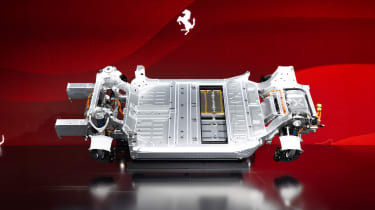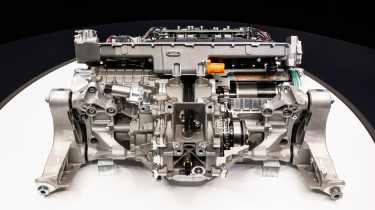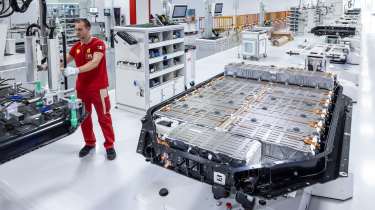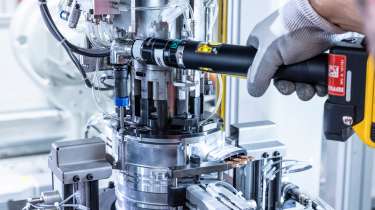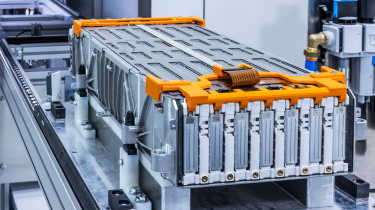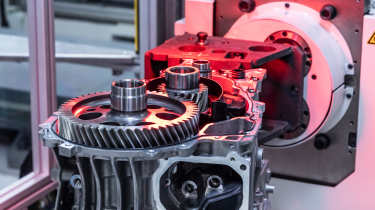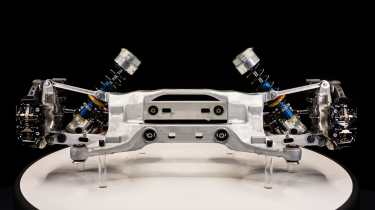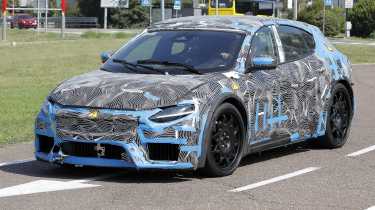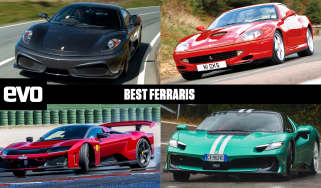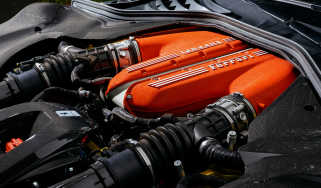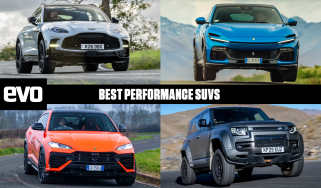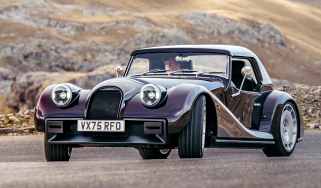The Ferrari Elettrica will be a practical electric four-door with hypercar power
It’s been decades in the making, but the time has finally come for Ferrari to uncover the details on its first electric car. We’ve been to Maranello for a closer look
Hot on the heels of the 849 Testarossa launch last month, Ferrari has lifted the lid on the most highly anticipated project in its 78-year history: the Elettrica, its first all-electric model. We’ll have to wait until Q2 2026 to see its final design (and final name), but in the meantime we have all of the details about what will make this EV deserving of the iconic Prancing Horse badge.
Joining a lineup of pure-combustion and plug-in hybrid models, this new offering will complete Ferrari’s range to make it as diverse as they come. In the years running up to this moment, the firm said it would only ever go all-electric when the technology was mature enough, and it seems now is that time. A culmination of technological research spanning all the way back to the F399 Formula 1 car of 2009, through the 2010 599 HY-KERS prototype, LaFerrari and recent hybrid offerings, this is no spur-of-the-moment project.
> Why Ferrari’s electric car might have the answer to EV depreciation
The basics are that the Elettrica is not a Rimac Nevera-rivalling hypercar, but instead the most usable Ferrari yet, also promising a more engaging driving experience than the Purosangue and GTC4 Lusso. Four doors, four seats and power to all four wheels are confirmed, but there’s no official word yet on the exact body style that will accompany it all. While there are endless ties back to the existing combustion lineup, Ferrari says this is a car built for new customers. Whether or not it will carry that trademark Ferrari character we know and love is something we’ll have to wait until next year to find out.
Powertrain, 0-62mph and top speed
With over 60 patented pieces of technology in this car, it’s clear that Ferrari has taken this project very seriously. Developing everything from the battery to the motor systems completely in-house, and even producing many of these components itself too, there’s a clear distinction between this and just about every other EV we’ve seen on the market.
Its raw performance comes from its electrified axles, each featuring two fixed-ratio synchronous permanent magnet motors for a total of four. This not only makes the car all-wheel drive, but also allows for torque vectoring capabilities far beyond those of an EV with a single motor on each axle. The motor tech is derived from that seen on Ferrari’s existing plug-in hybrid cars, utilising trick F1-derived Halbach array rotors to extract the most power from the least weight.
While the in-house-developed inverter (now just 9kg in weight and integrated within the motor housing itself) is capable of supplying up to 300kW (c400bhp), the front-axle motors combine to produce c280bhp and c200lb ft of torque in running order, which when combined with the c840bhp output of the rear axle makes for a total of over 1000bhp.
The likes of the SF90 feature a ‘front axle disconnect’ unit to disengage the front motors from the wheels when drive is not required, but this is an archaic system in comparison to the kind developed for this new EV. While the SF90’s unit was mounted separately, here it’s completely integrated to dramatically reduce size and weight. Select ‘Highway’ on the eManettino and the front motors will disconnect to make the car completely rear-wheel drive, maximising range as a result. In every other drivetrain mode the front-axle motor will be engaged, making the car all-wheel drive – with some very all-wheel-drive performance…
The 0-62mph sprint is quoted at 2.5sec, just two tenths behind the new plug-in-hybrid 849 Testarossa. Top speed is not quite as impressive at 193mph, putting it 12mph behind the 849 but a match for the pure-combustion Purosangue.
With such extreme performance (and, this being an EV, weight) comes the need to shed speed just as quickly as you pile it on. Carbon-ceramic friction brakes have been re-engineered for this application in order to reduce their mass: 390mm, six-piston units at the front, 372mm, four-piston at the rear. With four powerful motors at its disposal though, this system is assisted by up to 0.68 g of deceleration from regenerative braking alone, putting up to 500kW of energy back into the battery at its peak.
Battery
Powering the 800V system behind it all is a huge 122kWh liquid-cooled battery pack that Ferrari claims is the most energy-dense of any current electric car, at 195Wh/kg. (To save you doing the maths, that gives the battery pack a total weight of 626kg.) Integrated into the chassis structure for increased rigidity, a total of 14 nickel manganese cobalt pouch cells from South Korean firm ’SK on’ are packed into each of the 15 modules, of which 85 per cent are located below the floor pan. The rest are fitted neatly under the rear seats, resulting in 47:53 weight distribution.
Unlike some manufacturers, Ferrari will assemble these battery packs itself. It may receive the cells from elsewhere, but the rest will be done in-house, with the cells laser welded (not screwed, in order to save weight) into each module, and those modules then dropped into the larger packs – all at Maranello. It’s this that helps make the system futureproof, with Ferrari in control of every step in the process.
Something that’s proven to be especially key to maintaining both performance and value in EVs is battery health, but time will always have the final say when it comes to batteries built using 2025 technology. To ensure this is a ‘forever’ car like the rest of Ferrari's range, the firm says it’s ensured that, despite the complex packaging, there has been no compromise made to the ability to service and/or replace components, battery included. Avoiding a ‘cell-to-pack’ system makes each module replaceable separately should any of the 15 experience unusual ageing or damage.
Sound
As clever as all of this tech may be, sound is an important factor for any performance car, and especially one from Maranello. Ferrari has thought of this, and as opposed to replicating the sound of one of its V6, V8 or V12 engines, it’s amplifying the real sound of its electric powertrain instead. Mounted to the casing of the more powerful rear motor unit, an accelerometer picks up each and every vibration to translate this data into a sound precisely representative of powertrain response, in a similar fashion to an electric guitar pickup. So if you momentarily break traction, this will be represented in the sound you hear. This system is much more accurate than one synthesised based on throttle position or speed alone, and is designed to make the experience more authentic than in any other EV.
Ferrari won’t disclose all of the details about the system just yet, but it confirmed that unwanted sounds are filtered out to allow the best to come through. The company stopped short of saying it would pump this sound through the internal speaker system, but it’s fair to assume that this is the only way in which these sounds could make it into the cabin. Ferrari also hasn’t confirmed if the car will produce exterior sounds.
While there’s just a single pickup point, the decision on its location on the rear motor casing was far from random. A team of 20 engineers (of which many are ‘musically sensitive’) tried and tested 50 different locations for the pickup before making their final decision. The sensor is so sensitive that it’s able to distinguish vibrations from the left and right motors respectively, offering further feedback on what each of the rear wheels is doing. Given there are numerous points of contact for the signals at play in this system, there’s bound to be some latency, but Ferrari told evo that while it couldn’t offer an exact latency number, it’s ’imperceptible’ to the human ear.
Ferrari has made it clear that in normal driving scenarios this car remains completely silent, embracing the lack of sound associated with an electric powertrain. Its engineers have even gone as far as to actively cancel ‘undesirable’ harmonics associated with the powertrain through some very clever trickery within the inverter system that would require a PhD to fully understand. Request more power or engage the paddles (more on that to come) and the sound will return.
In addition to this focus on sound, Ferrari has developed what it’s calling ‘Torque Shift Engagement’ to boost driver involvement further. Using a paddle mounted to the right-hand side of the steering wheel, the driver can sequentially select five levels of power to ‘deliver progressively strong acceleration’. Meanwhile a left-hand paddle provides a ‘downshift effect’ under deceleration, increasing the engine braking effect. Sounds a lot like the simulated gearbox we saw on the Hyundai Ioniq 5 N…
Chassis and weight
It’s not just the basic motor technology that this car shares with its ICE relatives, as it also shares chassis components too. At its core is the same 48V Multimatic active suspension system first seen in the Purosangue and, more recently, the F80. The third-generation system is what lies beneath this car, now 2kg lighter per corner than in the Purosangue, but with even more capability.
Powering the system is a motor within each damper, but Ferrari has tweaked the thread of the central ‘screw’ for 20 per cent more pitch. The result of this change is that the system is even better than before at absorbing vertical movement, with precise control over lubrication thanks to the introduction of a thermocouple allowing the system to maintain the same lubricant viscosity no matter the external temperature.
As made clear by Ferrari CEO Benedetto Vigna, this is not a car built for YouTube drag races. While this system is more capable overall, it has been tweaked with comfort in mind for this car, leaning into its positioning as a more practical, usable model. NVH has been a very strong focus, to the point where Ferrari has even developed its very first suspended rear subframe for this application.
This is said to not only reduce transmission of motor and road noise, but also maintain the same rigidity as a solid-mounted unit. Clever tricks such as placing the inverters for each suspension tower within the subframe itself help improve NVH further, using their mass to dampen unwanted frequencies.
We’ll have to try it ourselves to know for sure, but Ferrari says this has all been achieved while maintaining the performance levels associated with one of its products. The claimed weight stands at a chunky 2300kg, although this is only 120kg more than a Purosangue (with fluids), despite the EV’s battery alone coming in at 626kg.
Ferrari claims the car feels as if it weighs 450kg less from the driver’s seat – in other words 1850kg. Rear-wheel steering is likely to contribute to this, with the rear wheels able to turn up to 2.15 degrees in each direction, even toeing in at high speeds for stability.
Design
The reveal of its final design will tell us much more, but Ferrari says this car will have a cab-forward design inspired by the company’s Berlinettas to put the driver much closer to the front axle than in any of its other models. The design change is so dramatic that the front crash structure has been reduced in size, and so the front suspension towers and motor assemblies are also now designed to absorb energy in the event of an impact.
What we do know about the model’s design is that it’s been finalised, with Vigna having already been behind the wheel in the last few weeks. We also know that at least part of the car has been designed in collaboration with Silicon Valley firm LoveFrom, headed by Apple’s ex-chief of design Jony Ive.
As part of this announcement, Ferrari has also unveiled the brand new ‘E-Vortex’ test circuit opposite Fiorano, designed to bring all of its testing in-house and away from prying eyes. Perhaps most impressive, and an indication of its dedication to the cause, is the timespan in which the circuit was built: just four months. It takes longer than that to fix a pothole in the UK…
While many manufacturers, including Porsche, have announced costly plans to drastically scale back their EV ambitions, Ferrari has made it clear that it’s going all-in on this project – CEO Benedetto Vigna said the company '...does what it says', sticking to its plan to begin the launch for this car in 2025.
Initial signs are certainly promising, and with this model set to coexist alongside combustion power, perhaps Maranello has positioned itself perfectly to tackle all ends of this segment. To find out more, we’ll have to wait until Q2 next year when it’s revealed in full.
Ferrari Elettrica specs
| Powertrain | Quad-motor, all-wheel drive |
| Power | c1000bhp |
| Torque | 731lb ft |
| 0-62mph | 2.5sec |
| Top sped | 193mph |
| Weight | c2300kg |
| Power-to-weight | 435bhp/ton |
| Battery size | 122kWh |
| Range | >329 miles |
| Price | TBC |
